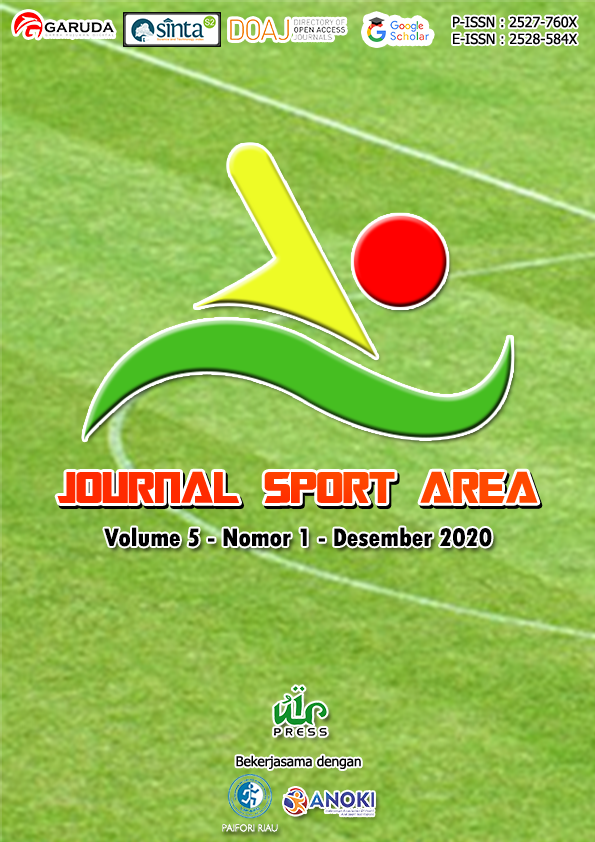Pengembangan Buku Pembelajaran Pendidikan Jasmani Bagi Anak Usia Dini
Keywords:
Book Text, Eearly Childhood, Physical EducationAbstract
The problem in this research is the availability of textbook teaching physical education for early childhood or manual for sports teachers in schools is still there, in the previous learning still uses the book physical education in general. The aim of this research is generating a guide text book for teacher at PAUD and Kindergarten in physical education and recreation learning. This study is the research of development that refers from Borg and Gall concept which is shortened to seven steps as needed. Small-scale testing involves 10 subjects and field testing involves 35 subjects. In order the resulting product can be valid so in this study involves three validators consisting of motor experts, physical education learning experts and early childhood education learning experts. From the result of small-scale trials of expert validation is obtained an average score of 3.5 with the category of "Good" and large-scale trial result of expert validation is obtained an average score of 3.9 with the category of "Good". Based on this assessment, it can be concluded that product of physical education learning textbooks for early childhood are considered suitable for used. For further research can be conducted effectiveness of textbooks that have been developed so that they can see how much influence this textbook in PAUD physical education learning.
Downloads
References
Adalikwu, S., & Iorkpilgh, I. (2013). The Influence of Instructional Materials on Academic Performance of Senior Secondary School Students in Chemistry in Cross River State. Global Journal of Educational Research, 12(1), 39–45. https://doi.org/10.4314/gjedr.v12i1.6
Best, J. R. (2010). Effects of physical activity on children’s executive function : Contributions of experimental research on aerobic exercise. Developmental Review, 30(4), 331–351. https://doi.org/10.1016/j.dr.2010.08.001
Clarke, G., & Kinchin, G. D. (2005). Sport Education in Physical Education. Routledge London; New York: Routledge.
Dini, U. (2017). Penggunaan Gadget terhadap Kemampuan Interaksi Sosial. Jurnal Obsesi : Jurnal Pendidikan Anak Usia Dini Analisis, 1(1), 1–11. https://doi.org/10.31004/obsesi.v1i1.26.
Dyson, B. (2014). Quality physical education: A commentary on effective physical education teaching. Research Quarterly for Exercise and Sport, 85(2), 144–152. https://doi.org/10.1080/02701367.2014.904155
Dyson, B. P., Linehan, N. R., & Hastie, P. A. (2010). The Ecology of Cooperative Learning in Elementary Physical Education Classes. Journal of teaching in Physical Education, 29(2), 113–130. https://doi.org/10.1123/jtpe.29.2.113.
Fogel, V. A., Miltenberger, R. G., Graves, R., & Koehler, S. (2010). The Effects of Exergaming on Physical Activity Among Inactive Children in a Physical Education Classroom. Journal of Applied Behavior Analysis, 43(4), 591–600. https://doi.org/10.1901/jaba.2010.43-591
Herdiyana, A., & Prakoso, G. P. W. (2016). Pembelajaran Pendidikan Jasmani yang Mengacu Pada Pembiasaan Sikap Fair Play dan Kepercayaan Pada Peserta Didik. Jurnal Olahraga Prestasi, 12(1), 115109. https://doi.org/10.21831/jorpres.v12i1.9498
Hermawan, H. A. (2011). Multilateral: Konsep dan Aplikasi Olahraga Anak Usia Dini. Thesis. Universitas Negeri Yogyakarta: FIK.
Irwansyah, I. (2018). Pengembangan Buku Ajar Teori Tenis Meja Bagi Mahasiswa Kelas A 2016 Jurusan PJKR IKIP Budi Utomo Malang. JP.JOK (Jurnal Pendidikan Jasmani, Olahraga dan Kesehatan), 1(2), 47–59. https://doi.org/10.33503/jpjok.v1i2.166
Karnik, S., & Kanekar, A. (2012). Childhood obesity: A global public health crisis. International Journal of Preventive Medicine, 3(1), 1–7. https://doi.org/10.1201/b18227-3
Pelana, R. (2014). Fun learning management for physical education, sport and health. Asian Social Science, 10(5), 85–90. https://doi.org/10.5539/ass.v10n5p85
Pill, S. (2011). Teacher engagement with teaching games for understanding - game sense in physical education. Journal of Physical Education & Sport/Citius Altius Fortius. 11(2), 115–123.
Rosidah, R., & Sumarni, S. (2017). Kelompok B di TK Negeri Pembina Indralaya Selatan. Jurnal Tumbuh Kembang, 4(2017), 45–51.
Sanusi, R., & Widiyanto, W. (2018). Pengembangan model aquarobic exercise untuk pembakaran lemak pada overweight. Jurnal Keolahragaan, 6(2), 139–149. https://doi.org/10.21831/jk.v0i0.8560
Schwamberger, B., & Sinelnikov, O. (2015). Connecting physical education to out-of-school physical activity through sport education. Journal of Physical Education, Recreation & Dance, 86(9), 39–44. https://doi.org/10.1080/07303084.2015.1085344
Suharnoko, F., & Firmansyah, G. (2018). Pengembangan Model Pembelajaran Melompat Melalui Permainan Lompat Cermin untuk Siswa Sekolah Dasar. Jurnal SPORTIF : Jurnal Penelitian Pembelajaran, 4(2), 145. https://doi.org/10.29407/js_unpgri.v4i2.12169
Surahman, F., & Yeni, O. H. (2019). Pengembangan Buku Ajar Mata Kuliah Renang Bagi Mahasiswa Pendidikan Jasmani Kesehatan dan Rekreasi. Journal Sport Area, 4(1), 218–229. https://doi.org/10.25299/sportarea.2019.vol4(1).2413
Undang-Undang Republik Indonesia. (2005). Sistem Keolahragaan Nasional. Dewan Perwakilan Rakyat dan Presiden Republik Indonesia.
Published
How to Cite
Issue
Section
This is an open-access article distributed under the terms of the Creative Commons Attribution-ShareAlike 4.0 International License which permits unrestricted use, distribution, and reproduction in any medium. Copyrights of all materials published in Journal Sport Area are freely available without charge to users or / institution. Users are allowed to read, download, copy, distribute, search, or link to full-text articles in this journal without asking by giving appropriate credit, provide a link to the license, and indicate if changes were made. All of the remix, transform, or build upon the material must distribute the contributions under the same license as the original.
Accepted 2020-07-23
Published 2020-11-18












